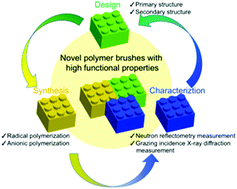Control of the primary and secondary structure of polymer brushes by surface-initiated living/controlled polymerization
Abstract
Characterization of the molecular structure of high-density well-defined polymer brushes with predictable number-average molecular weight (Mn), narrow molecular weight dispersity (MWD), and highly ordered tacticity, prepared by surface-initiated controlled radical polymerization or living anionic polymerization, is described. Ionic monomers, such as 3-(N-2-methacryloyloxyethyl-N,N-dimethyl)ammonatopropanesulfonate (MAPS), were polymerized by atom transfer radical polymerization in 2,2,2-trifluoroethanol in the presence of imidazolium chloride to give a polymer with Mn greater than 2 × 105 g mol−1 maintaining a narrower MWD (Mw/Mn < 1.2). Neutron reflectivity measurement of poly(MAPS) (PMAPS) brushes at the water interface revealed that polymer brushes with narrow MWD form a relatively sharp boundary at the solution interface, while brushes with a broad MWD show a gradient solution interface due to the variety of chain length. The effect of MWD on swollen chain structure is described. This article also reviews surface-initiated stereospecific polymerization. High density poly(methyl methacrylate) (PMMA) brushes with well-controlled primary structures were prepared on flat and spherical substrates using surface-initiated living anionic polymerization in the presence of triethyl aluminum. The PMMA brushes so obtained showed highly controlled stereoregularity (rr > 88%). Grazing incidence wide-angle X-ray diffraction (GIWAXD) measurements indicated that the stereoregular PMMA brushes formed helical structures with about 1 nm diameter and encapsulated fullerenes in the cavities.



 Please wait while we load your content...
Please wait while we load your content...